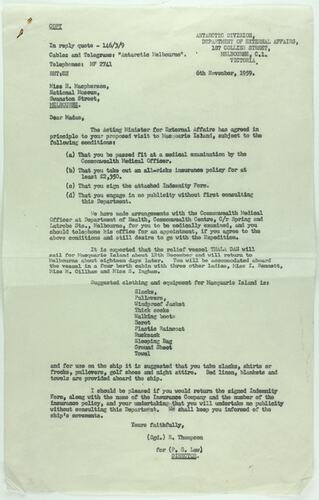Summary
Carbon copy of letter from Antarctic Division, Department of External Affairs to Hope Macpherson, National Museum, confirming proposed visit to Macquarie Island provided certain conditions are met, advising travel arrangements, recommending clothing and personal items that will be required, and copy of agreement.
Hope Macpherson was the first female curator at National Museum of Victoria (now Museum Victoria). Hope along with Isobel Bennett, Susan Ingham and Mary Gillham were the first women to visit the Antarctic in their December 1959 expedition.
Description of Content
Colour portrait of Hope Macpherson wearing a knitted top light olive green, collar edged in a lighter colour, pink bow in front on neck line, wearing glasses and not smiling. Image mounted on offwhite backing card that has some foxing.
Physical Description
Carbon copy type written letter of one page with two page agreement attached, from Antarctic Division, Department of External Affairs to Miss H Macpherson, National Museum, reference No. 146/3/9, signed R Thompson for PG Law, director, advising the agreement that Hope visit Macquarie Island providing four conditions are met, advising travel arrangements and recommending clothing and personal items that would be required.
Significance
The Hope (Macpherson) Black Collection is a significant addition to Museum Victoria's working lives collection, it reveals the journey of a woman from depression era Melbourne and illustrates the power of education. It also reveals the often discriminatory policies in place in Victoria before the equal opportunity developments of the late 20th century. In balance though it also exposes the somewhat free expression possible for empowered women in this period. Hope Macpherson clearly states that in her day to day work she never felt discrimination and believes she was given great opportunity to pursue her career and aspirations. However, on analysis her role was often shaped by her gender and its perceived strengths and weaknesses; she was dissuaded from applying to become a taxidermist as it was 'an unsuitable job for a woman', although part of the first group of female scientists allowed to travel to Macquarie Island they were not permitted to camp on land with the male crew for fear of inciting passions. And finally after a distinguished career she was forced to resign her tenure as Australia's first female Curator when she married late in life, as a consequence of the Marriage bar.
More Information
-
Collection Names
-
Collecting Areas
-
Acquisition Information
Donation from Hope Black (nee Macpherson), Apr 2011
-
Addressed To
Miss Hope Macpherson - National Museum of Victoria, Melbourne, Victoria, Australia, 06 Nov 1959
-
Sender
Department of External Affairs, Antarctic Division, 187 Collins Street, Melbourne, Greater Melbourne, Victoria, Australia, 06 Nov 1959
-
Classification
-
Category
-
Discipline
-
Type of item
-
Overall Dimensions
337 mm (Length), 210 mm (Width)
-
Keywords




